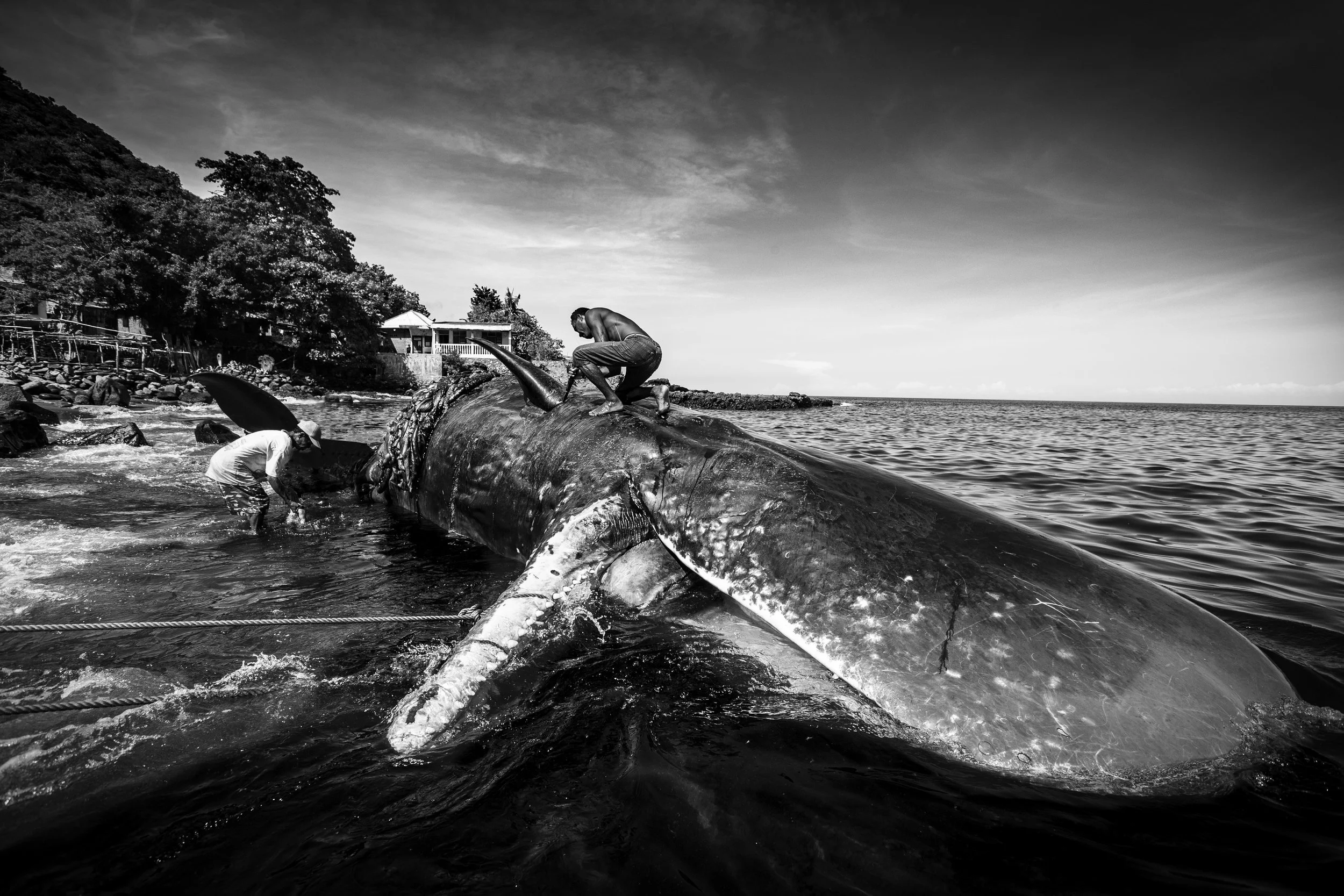
Latitude 8.5697° S Longitude 123.3991° E
This is a story about a photojournalist’s struggle
to capture the elusive photo; a village whose
cultural identity is under threat and the planet’s
natural environment that is forever changing.






Hunting Whales and the Perfect Image
His slim muscular body is balanced on the platform at the bow of the hunting boat. His head moves from side to side, eyes constantly scanning the ocean, untroubled by the glare off the water. Paulus Pulo stands relaxed and controlled. His left-hand gives directions relayed down the boat by its rag-tag crew to the driver of the outboard motor. Paulus’s right-hand rests near his shoulder, grasping a four-metre-long bamboo pole with a curved harpoon blade pointed out above the spray from the bow.
I had spent years waiting for this moment. Since 2017, I have travelled to the small village of Lamalera to document the world’s last community where men still hunted sperm whales by hand. The glistening, blackened back of a young bull sperm whale breaks the surface as it slides through the ocean on its annual pilgrimage, unaware of the danger he is about to encounter. The whale exhales, letting out a breath that sounds like a giant whoooomph! Then it fills its enormous lungs with air again, in anticipation of a possible dive that could last thirty minutes or more. The rough hand-crafted wooden boat edges closer to its prey. The crew of men in dirty T-shirts, torn shorts and sarongs wrapped around their shoulders have stopped the vessel’s outboard motor and are using hand-carved paddles to continue the chase. The harpooner steadies and locks his eyes on the massive whale that appears just 100 or so metres away. The boat, called a ‘téna’, stares in the direction of the whale, through a set of eyes painted on the starboard and port sides to ward off evil spirits. I ready myself – checking my camera settings while anticipating the harpooner’s next move, known as the ‘lama fa’. The harpooner with astounding courage, will launch himself into the water and drive his harpoon into the whale’s side. Adrenalin pumps through my body. I have totally forgotten the fact that we are chasing a mammal that is approximately twice the length of our boat, outweighing the vessel by five or six times. I look down to my bare feet and realise, they are placed in a coil of rope that could possibly be attached to the end of the lama fa’s harpoon – I quickly move to a safer position. This is the moment I have come to Lamalera to see,to capture, to document – the whale hunt. The majestic cetacean seems to sense the encroaching boat and increases its speed through the sapphire waters of the Savu Sea. The crew start chanting as they dig their paddles deep, trying to close the gap between the téna and the whale. I can see that the pursuit is useless. The gap is widening. I feel a knot of anxiety forming in my stomach. I’m not sure whether I should shout, scream or cry. I have become so obsessed with chasing my perfect image, selfishness takes over.
I have no regard for the whale’s life or the village’s survival. A voice inside my head begs the whale to slow down and to sacrifice itself for my perfect photo. I have lost all sense of reality. But it’s the whale that has the last say. As quickly as the great mammal comes to the surface, he raises his giant flukes, as if waving goodbye, before diving into the blue depths. Aboard our téna, the crew and the lamfara begin shouting. It’s unclear who is blaming who, but it seems the crew are yelling at the harpooner for leaving his chance of throwing his harpoon at the whale for far too long, and he is blaming the crew for not rowing fast enough.
For me, this is the ultimate disappointment. I missed the shot, missed what I have come to Lamalera for – the chance to capture a successful whale hunt. Rumours begin circulating in the village that maybe my presence has brought bad luck. It is day 23 of my stay in Lamalera, and I am totally deflated.







Are you interested in a LATITUDE 8.5697° S LONGITUDE 123.3991° E limited-edition photographic book?
The idea behind this book began as a project for my Master in Advanced Journalism course. After much advice and help from friends, colleagues and mentors, my project evolved into a high-quality photographic book with 55 excellent black-and-white photos and approximately 8,000 words that showcases and examines a self-reflective exploration of experiencing, photographing, and writing about traditional whale hunting in Indonesia.
Today, book publishing has been revolutionised by small printing publishers taking on new digital print technology that allows artists to self-publish work in small edition sizes – and given the decreasing interest from more prominent trade publishers in printing art or photography publications, it’s somewhat the only solution to creating a hard copy of photojournalistic art.
LATITUDE 8.5697° S LONGITUDE 123.3991° E was designed by acclaimed graphic designer Georgia Willis. There will only be 25 copies ever printed in this layout, and the author will sign each book along with the edition number of 25.
Unfortunately, I have learnt that self-publishing, a limited edition, high-quality, handmade photographic book comes at a hefty price….. $240 per book!
The printers at Momento Pro have used only the highest quality materials and hand-crafted each copy of the 420 x 297mm, 128-page book into a true work of art. If you’re a lover of photojournalism or collect limited-edition books, then LATITUDE 8.5697° S LONGITUDE 123.3991° E, is for you.
If you are interested in purchasing a copy, please send me your name and email, and I will contact you regarding payment and book/print delivery.
To all of you that have supported and encouraged me over the years, I thank you.
Cheers,
Paul.
Paul.Jones@uts.edu.au
0407122045

